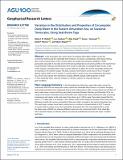Files in this item
Variation in the distribution and properties of Circumpolar Deep Water in the eastern Amundsen Sea, on seasonal timescales, using seal-borne tags
Item metadata
| dc.contributor.author | Mallett, Helen K. W. | |
| dc.contributor.author | Boehme, Lars | |
| dc.contributor.author | Fedak, Mike | |
| dc.contributor.author | Heywood, Karen J. | |
| dc.contributor.author | Stevens, David P. | |
| dc.contributor.author | Roquet, Fabien | |
| dc.date.accessioned | 2018-05-25T08:30:12Z | |
| dc.date.available | 2018-05-25T08:30:12Z | |
| dc.date.issued | 2018-05-24 | |
| dc.identifier | 250569801 | |
| dc.identifier | 139b0eaa-fd78-4e5c-907c-c6155db959e6 | |
| dc.identifier | 85047522403 | |
| dc.identifier | 000435262000050 | |
| dc.identifier.citation | Mallett , H K W , Boehme , L , Fedak , M , Heywood , K J , Stevens , D P & Roquet , F 2018 , ' Variation in the distribution and properties of Circumpolar Deep Water in the eastern Amundsen Sea, on seasonal timescales, using seal-borne tags ' , Geophysical Research Letters , vol. Early View . https://doi.org/10.1029/2018GL077430 | en |
| dc.identifier.issn | 1944-8007 | |
| dc.identifier.other | ORCID: /0000-0002-9569-1128/work/47136224 | |
| dc.identifier.uri | https://hdl.handle.net/10023/13535 | |
| dc.description | The work was funded by the UK Natural Environment Research Council (NERC) iSTAR Programme through grants NE/J005703/1 (Karen Heywood and David Stevens) and NE/JOO5649/1 (Mike Fedak) and by the NERC EnvEast Doctoral Training Partnership through grant NE/L002582/1 (Helen Mallett). Lars Boehme was supported by the MASTS pooling initiative (The Marine Alliance for Science and Technology for Scotland), and their support is gratefully acknowledged. MASTS is funded by the Scottish Funding Council (grant reference HR09011) and contributing institutions. | en |
| dc.description.abstract | In the Amundsen Sea, warm saline Circumpolar Deep Water (CDW) crosses the continental shelf toward the vulnerable West Antarctic ice shelves, contributing to their basal melting. Due to lack of observations, little is known about the spatial and temporal variability of CDW, particularly seasonally. A new dataset of 6704 seal‐tag temperature and salinity profiles in the easternmost trough between February and December 2014 reveals a CDW layer on average 49 db thicker in late winter (August to October) than in late summer (February to April), the reverse seasonality of that seen at moorings in the western trough. This layer contains more heat in winter, but on the 27.76 kg/m3 density surface CDW is 0.32° C warmer in summer than winter, across the northeastern Amundsen sea, which may indicate wintertime shoaling offshelf changes CDW properties onshelf. In Pine Island Bay these seasonal changes on density surfaces are reduced, likely by gyre circulation. | |
| dc.format.extent | 9 | |
| dc.format.extent | 2299780 | |
| dc.language.iso | eng | |
| dc.relation.ispartof | Geophysical Research Letters | en |
| dc.subject | Pine Island Glacier | en |
| dc.subject | Ice-melt | en |
| dc.subject | Circumpolar Deep Water | en |
| dc.subject | Amundsen Sea | en |
| dc.subject | GC Oceanography | en |
| dc.subject | GE Environmental Sciences | en |
| dc.subject | NDAS | en |
| dc.subject.lcc | GC | en |
| dc.subject.lcc | GE | en |
| dc.title | Variation in the distribution and properties of Circumpolar Deep Water in the eastern Amundsen Sea, on seasonal timescales, using seal-borne tags | en |
| dc.type | Journal article | en |
| dc.contributor.sponsor | NERC | en |
| dc.contributor.institution | University of St Andrews. School of Biology | en |
| dc.contributor.institution | University of St Andrews. Sea Mammal Research Unit | en |
| dc.contributor.institution | University of St Andrews. Marine Alliance for Science & Technology Scotland | en |
| dc.contributor.institution | University of St Andrews. Scottish Oceans Institute | en |
| dc.identifier.doi | 10.1029/2018GL077430 | |
| dc.description.status | Peer reviewed | en |
| dc.identifier.url | https://agupubs.onlinelibrary.wiley.com/doi/10.1029/2018GL077430 | en |
| dc.identifier.grantnumber | NE/J005649/1 | en |
This item appears in the following Collection(s)
Items in the St Andrews Research Repository are protected by copyright, with all rights reserved, unless otherwise indicated.

